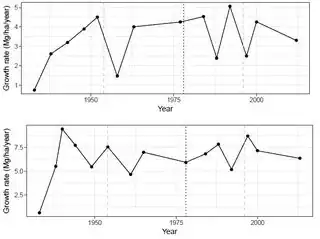The Data
Total Biomass and Annual Growth Rates for 37 permanent sample (i.e., repeated sample) forest plots that have been resampled at different intervals (and sometimes in different years) for 80 years.
- Note: additional confounding variables (e.g., soil nutrients, forest age, etc.) do exist and would likely need to be incorporated in my final model.
Scientific question
Are forest growth rates increasing through time?
Data Structure
The growth rates are clearly more complicated than a linear trend -- they're highly variable within plots and between plots. See growth rates for 2 of the 37 plots below:
Stats Question
I know that ARMA models are often used for time series data, but Ives et al. (2010) don't mention this type of data as a candidate for ARMA analyses; instead they mention using ARMA for population densities.
My question: Would an ARMA(p,q) model be an appropriate approach for determining an increasing trend in my time series data??
If not, what alternative analysis approach would be more appropriate/valid for my data?
- Some sort of mixed model, perhaps?
Update
Actually, is it true that an ARMA model is only appropriate if the observations are equally spaced in time?
If so, what options do I have for my data which are not evenly spaced in time???
Cited: Ives, A.R., Abbott, K.C. and Ziebarth, N.L., 2010. Analysis of ecological time series with arma (p, q) models. Ecology, 91(3), pp.858-871.
